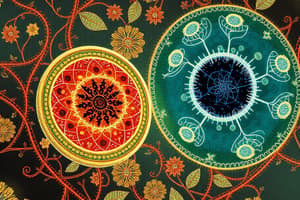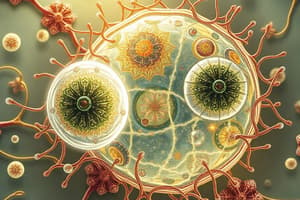Podcast
Questions and Answers
The Cell Theory states that all organisms are composed of one or more ___
The Cell Theory states that all organisms are composed of one or more ___
cells
What is the smallest structural and functional unit of life?
What is the smallest structural and functional unit of life?
cell
Prokaryotic DNA consists of multiple linear double-stranded strands.
Prokaryotic DNA consists of multiple linear double-stranded strands.
False (B)
Why are eukaryotic cells larger than prokaryotic cells?
Why are eukaryotic cells larger than prokaryotic cells?
What determines the size of the cell?
What determines the size of the cell?
What is the region where prokaryotic circular DNA is located?
What is the region where prokaryotic circular DNA is located?
Which of the following structures do prokaryotic cells lack?
Which of the following structures do prokaryotic cells lack?
What are the primary components of the cytoskeleton?
What are the primary components of the cytoskeleton?
What is the function of ribosomes?
What is the function of ribosomes?
What type of membrane do mitochondria have?
What type of membrane do mitochondria have?
Lysosomes are involved in recycling the cell's own organelles.
Lysosomes are involved in recycling the cell's own organelles.
What is the site for photosynthesis in plant cells?
What is the site for photosynthesis in plant cells?
Cell walls provide support, structure, and protection as they are perforated with ___
Cell walls provide support, structure, and protection as they are perforated with ___
Which organelle sorts finished proteins into transport vesicles?
Which organelle sorts finished proteins into transport vesicles?
Flashcards are hidden until you start studying
Study Notes
The Cell: An Overview
- The Cell Theory postulates that all living organisms are composed of cells, which are the basic units of life, and that cells originate from preexisting cells.
- Prokaryotic cells contain one circular double-stranded DNA, while eukaryotic cells have multiple linear double-stranded DNA.
- Eukaryotic cells are generally larger due to their complexity and the presence of membrane-bound organelles.
Characteristics of Prokaryotic Cells
- Lack of nucleus and membrane-bound organelles.
- Circular DNA located in a nucleoid, not enclosed by a membrane.
- Basic structures include ribosomes, a cell wall, capsule, and plasma membrane.
- Capable of respiration and photosynthesis, often equipped with flagella and pili for movement and attachment.
- Prokaryotes display extreme versatility, utilizing various substances for energy and carbon, and can thrive in diverse environments.
Eukaryotic Cell Structure
- The nucleus houses most of the cell's DNA and genes, surrounded by a double-layered nuclear envelope with pore complexes.
- Genetic material is organized as chromatin, which condenses into chromosomes during cell division.
- The nucleolus within the nucleus is the site of ribosomal RNA synthesis.
Ribosomes
- Composed of ribosomal RNA and proteins.
- Responsible for protein synthesis, with free ribosomes located in the cytosol and bound ribosomes on the endoplasmic reticulum.
Endomembrane System
- A network of internal membranes that compartmentalizes the cell into organelles.
- Regulates protein traffic and carries out metabolic processes.
- Key components include the nuclear envelope, endoplasmic reticulum (ER), Golgi apparatus, lysosomes, vesicles, and plasma membrane.
Endoplasmic Reticulum (ER)
- Rough ER (RER) is studded with ribosomes; synthesizes proteins for membranes or secretion.
- Smooth ER (SER) is ribosome-free and synthesizes lipids, also detoxifies harmful substances.
Golgi Complex
- Composed of flattened membranous sacs; modifies proteins from the rough ER.
- Sorts and packages proteins into vesicles for secretion or incorporation into membranes.
Lysosomes
- Membrane-bound sacs filled with hydrolytic enzymes for digestion of macromolecules.
- Recycle cellular components and are involved in cellular digestion processes.
Mitochondria
- Function as the site of cellular respiration, generating ATP.
- Contain their own DNA and are composed of a double membrane; the inner membrane forms cristae and the matrix contains metabolic enzymes.
Cytoskeleton
- Provides structural support and shape to cells; composed of microtubules, intermediate filaments, and microfilaments.
- Facilitates cell motility through interaction with motor proteins and serves as tracks for vesicle transport.
Centrosomes and Centrioles
- The centrosome is the organizing center for microtubules, forming the spindle apparatus during cell division.
- In animal cells, centrosomes contain a pair of centrioles.
Peroxisomes
- Contain enzymes that convert hydrogen peroxide into water, thus detoxifying harmful substances.
Chloroplasts
- Organelles responsible for photosynthesis, containing their own DNA and ribosomes; have a double membrane and structures called grana.
Vacuoles
- Food vacuoles are formed through phagocytosis; contractile vacuoles manage water balance in some cells, while central vacuoles in plants store organic compounds and water.
Cell Wall
- Provides physical support and protection to plant cells, perforated with plasmodesmata for cell communication.
Animal Cell Surface
- Cell surface molecules facilitate adhesion, communication, and organization among cells, crucial for tissue formation and function.
Studying That Suits You
Use AI to generate personalized quizzes and flashcards to suit your learning preferences.



